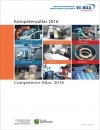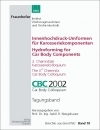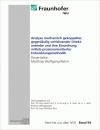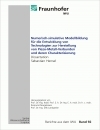| ||||
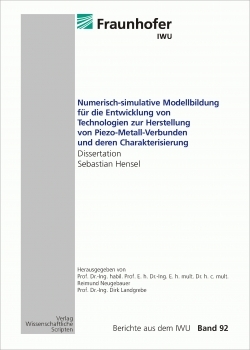
| ||||
|
R. Neugebauer (Hrsg.) Numerisch-simulative Modellbildung für die Entwicklung von Technologien zur Herstellung von Piezo-Metall-Verbunden und deren Charakterisierung
Berichte aus dem IWU, Band 92 165 Seiten, m. Abb. und Tab., A5, Broschur ISBN: 9783957350442 Verlag Wissenschaftliche Scripten Piezokeramik-Metall-Verbunde besitzen eine lasttragende metallische Schicht, eine Deckschicht sowie ein integriertes Piezofasermodul zur erweiterten adaptronischen Funktionalisierung dieser Bauteile. Bei der Herstellung der Verbunde wird das Piezofasermodul mit den umgebenden Blechstrukturen mitverformt. Das Modul ist hierbei schwimmend in flüssigem Klebstoff gelagert, wodurch kritische Spannungen drastisch reduziert werden. Nach dem Formgebungsschritt härtet der Klebstoff vollständig aus und sorgt so für eine steife Anbindung des Fasermoduls an die Bleche. Trotz der fluidischen Lagerung kann die Umformung der Bleche geometrische Zwangsbedingungen generieren, welche erhebliche Membrandehnungen in das Piezomodul einleiten. Nach einer einmaligen Überbelastung während der Herstellung, ist möglicherweise eine Verringerung der Funktionalität der Piezokeramik-Metall-Verbunde die Folge. In der vorliegenden Arbeit wird eine Methodik entwickelt, mit der die Reduzierung der Funktionalität von Piezokeramik-Metall-Verbunden aufgenommen sowie in der numerischen Simulation zur rechnerischen Bestimmung der Restfunktionalität genutzt werden kann. In einfachen Grundversuchen erfolgt eine Bestimmung der Verminderung der Piezomodul-Performance in Abhängigkeit von Belastungshöhe und -richtung. Die Ergebnisse werden in ein Modell zur Vorhersage der Restperformance überführt, welches in Simulationen zur Umformung von Piezokeramik-Metall-Verbunden mit dem Experiment validiert wird. Im Vordergrund steht die Erarbeitung einer Systematik, die eine Vorhersage der sich nach dem Umformschritt einstellenden Funktionalität ermöglicht. Schon im Vorfeld der Produkt- und Prozesskettenplanung steht somit eine Beschreibung zur Verfügung, mit der die Effizienz des Herstellungsprozesses beurteilt werden kann.
Piezoceramic-metal-compounds use a metallic load transmitting layer, a cover sheet and an integrated piezoceramic fibre module to extent the functionality of structural parts for adaptronic applications. The piezoceramic module is deformed by the surrounding metallic sheets during the part production. Within the process, a lubricated floating bearing, implemented by usage of a liquid adhesive, reduces the module stresses drastically to a non-critical level compared with the case of a completely tied module. The adhesive fully cures after the shaping operation is performed and thus secures a stiff joint between the piezoceramic fibre module and the surrounding sheet metals. Despite the lubricated floating bearing, shaping of the sheet metals may cause geometric constraints, which induce significant membrane strains in the fibre module. This possible one-off overload during the production process can cause a reduction of the functionality of piezoceramicmetal-compounds. In this thesis a method is developed that can be used to determine the functionality reduction of piezoceramic-metal-compounds and utilises the results in numerical simulations to predict the residual performance of such structural parts. The decrease of the piezoceramic module performance dependent on load level and direction is investigated with basic experiments. With the results a performance model is derieved. It is further validated by the comparison of simulations and experimental results of the compound shaping operation. The thesis focuses on the development of a methodology, that allows for a prediction of the adaptronic part functionality after shaping operation. As a result, within the early product and process chain design stage, a tool is available to evaluate the effeciency of the process.
| ||||
|
| ||||

